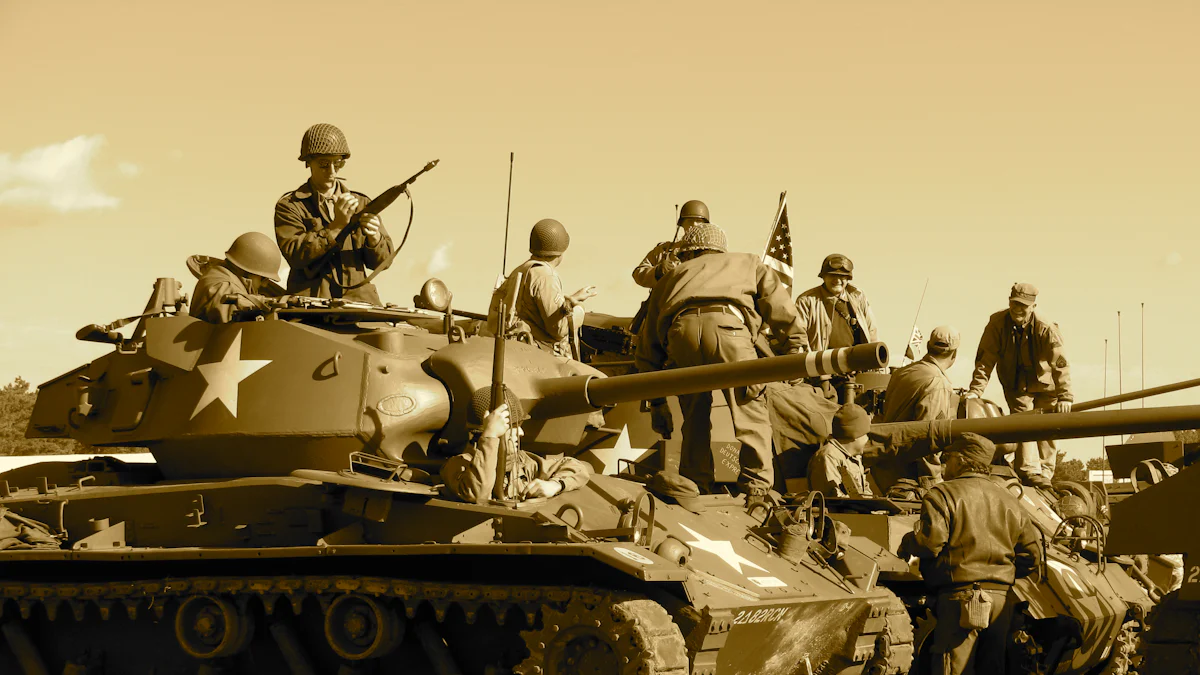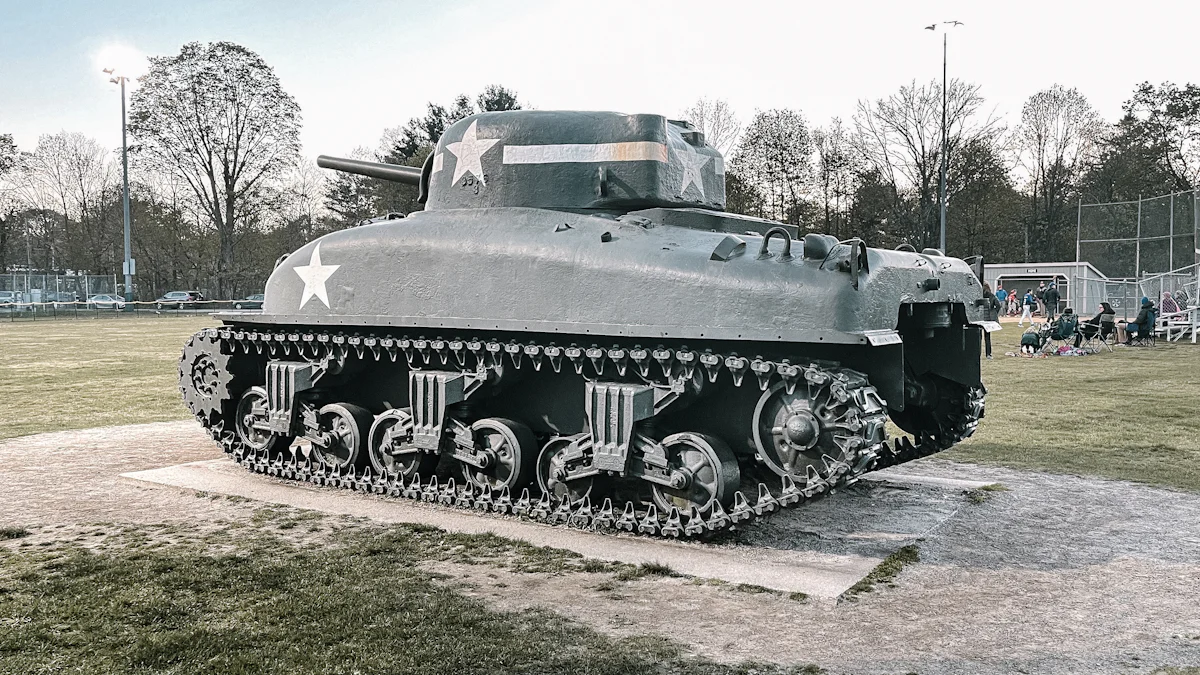Tank: The Definitive Visual History of Armored Vehicles

Tanks have profoundly influenced the history of warfare, evolving from basic armored vehicles to advanced machines. The Definitive Visual History of these vehicles illustrates their transformation. The Tank Museum at Bovington provides insights into this history. David Willey, a curator at the museum, emphasizes the visual journey of armored vehicles. The Smithsonian has contributed to the book, ensuring accuracy. Reviews commend the book for its detailed visual history. The Smithsonian books collection features this essential visual history. The History of Armored Vehicles is vital for understanding military evolution.
The Birth of Tanks

The First Tank in 1916
Development and Deployment
In early 1915, Britain began the serious development of the tank. Engineers sought to create a new type of armored vehicle. The goal was to break the stalemate of trench warfare. The first successful deployment occurred during the Battle of the Somme. On September 15, 1916, British forces used tanks in combat for the first time. These vehicles changed the dynamics of battle. General Douglas Haig witnessed their potential. He ordered the production of hundreds more.
Specifications and Performance
The initial tank models had specific features. These vehicles weighed around 28 tons. The armor provided protection against small arms fire. The tanks moved at a speed of about 4 miles per hour. The design included caterpillar tracks. This innovation allowed tanks to cross trenches and wire entanglements. The psychological impact on enemy troops was significant. German morale suffered when faced with these formidable machines.
Early Technological Advancements
Innovations in Design
Early tanks showcased remarkable innovations. Engineers focused on improving mobility and firepower. The use of caterpillar tracks became standard. This design choice allowed vehicles to traverse difficult terrain. The development of rotating turrets enhanced combat effectiveness. Engineers also experimented with different armaments. Machine guns and cannons became common features.
Impact on World War I
Tanks revolutionized warfare during World War I. The introduction of these vehicles broke the trench warfare stalemate. Tanks provided mobile direct fire support. This capability proved crucial in several battles. British forces effectively used tanks at the Battle of Flers-Courcelette. Tanks demonstrated their value by crossing trenches and barbed wire. The presence of tanks on the battlefield had a dramatic effect on enemy morale. The success of tanks in World War I paved the way for future advancements.
Tanks in World War II

Key Models and Their Roles
German Panzer Series
The German Panzer series played a pivotal role during WWII. Engineers designed these tanks to integrate seamlessly into military strategies. The Panzers offered mobile firepower and protection on the battlefield. German forces utilized these tanks effectively in combined-arms operations. This approach included artillery, infantry, and air support. The Panzer series demonstrated versatility in various combat scenarios. The tanks provided a significant advantage in early WWII battles.
Allied Sherman Tanks
The Allied Sherman tanks became a crucial asset in WWII. These tanks offered reliability and ease of production. The Sherman tanks supported infantry units and engaged enemy targets. Allied forces used these tanks extensively in Europe and North Africa. The Shermans excelled in combined-arms roles, enhancing their effectiveness. The tanks contributed to key victories by providing mobile firepower. The Sherman tanks symbolized Allied strength and resilience.
Technological Breakthroughs
Armor and Armament Enhancements
WWII saw significant advancements in tank armor and armament. Engineers focused on improving protection and firepower. Tanks received thicker armor to withstand enemy attacks. The development of more powerful guns increased combat effectiveness. These enhancements allowed tanks to engage enemy vehicles with greater success. The improvements in design marked a turning point in armored warfare.
Tactical Innovations
Tactical innovations transformed tank warfare during WWII. Military strategists developed new methods for deploying tanks. The use of tanks in blitzkrieg tactics showcased their potential. Rapid advances and coordinated assaults became possible. Tanks provided mobile direct fire support in various operations. The integration of tanks into broader military strategies proved essential. These innovations shaped the future of armored combat.
Post-War Developments
Korean and Vietnam Wars
Tank Usage and Strategies
The Korean War saw tanks playing a crucial role in ground operations. Tanks provided mobile firepower and engaged enemy armored vehicles. Infantry units relied on tanks for support during offensive maneuvers. Tanks breached enemy defenses and facilitated rapid advances. Urban combat required tanks to serve as armored shields for infantry.
In Vietnam, tanks adapted to jungle warfare. The terrain posed challenges, but tanks offered protection and firepower. Tanks supported infantry by engaging fortified positions. The adaptability of tanks proved essential in diverse combat scenarios.
Lessons Learned
The Korean and Vietnam Wars highlighted the need for tank versatility. Tanks demonstrated the ability to adapt to different terrains and combat situations. Engineers focused on improving mobility and protection. Lessons from these conflicts influenced future tank designs. Tanks continued to evolve, maintaining their relevance in modern warfare.
Cold War Era
Evolution of Tank Design
The Cold War era marked significant advancements in tank design. Engineers prioritized mobility, firepower, and protection. Tanks integrated new technologies to enhance battlefield performance. The development of advanced armor and weaponry became a focus. Tanks evolved to meet the demands of changing military doctrines.
Influence on Military Doctrine
Tanks shaped military strategies during the Cold War. The integration of tanks into combined arms operations became standard. Tanks provided essential capabilities in both offensive and defensive maneuvers. Military planners recognized the great versatility of tanks. The full history of tanks showed their impact on modern military doctrine.
Modern Tanks and Their Relevance
Technological Evolution
Advanced Armor and Weaponry
Modern tank development focuses on enhancing armor and weaponry. Engineers design tanks with advanced composite armor to withstand various threats. The use of reactive armor provides additional protection against anti-tank weapons. Main Battle Tanks (MBTs) feature powerful main guns, such as the 120mm and 125mm calibers. These guns deliver kinetic energy penetrators and chemical energy shells. Tanks adapt to combat needs through advancements in turret designs and ammunition storage.
Military Experts highlight the versatility of tank firepower:
"Currently, the most common main gun calibers on modern Main Battle Tanks (MBTs) are 120mm in Western-built tanks and 125mm smoothbore in Eastern-built tanks. These guns effectively deliver kinetic energy penetrators (KEP) and chemical energy shells (CEP) to engage a wide range of targets."
Integration of Digital Systems
Digital systems play a crucial role in modern tank operations. Tanks incorporate advanced fire control systems (FCS) for precise targeting. High-performance computers and laser rangefinders enhance accuracy. Tanks utilize crosswind sensors for effective target engagement on the move. Situational awareness improves through digital integration, enhancing hunter-killer capabilities.
Military Experts emphasize the importance of FCS evolution:
"The evolution of FCS, from analog technology to transistors, has significantly improved a tank’s ability to deliver firepower accurately."
Role in Contemporary Military Strategy
Adaptation to Modern Warfare
Tanks serve as indispensable assets in modern warfare. Tanks provide mobile firepower platforms for engaging enemy forces. Infantry units rely on tanks for support during offensive operations. Tanks breach enemy defenses and facilitate rapid advances. Urban combat benefits from tanks serving as armored shields for infantry.
Military Experts describe the multifaceted role of tanks:
"Tanks play a multifaceted role on the modern battlefield. They possess unique capabilities that make them indispensable assets for ground operations."
Future Prospects
The future of tanks involves continued technological advancements. Engineers focus on improving mobility, protection, and firepower. The integration of early warning systems enhances survivability. Laser warning systems alert crews to potential threats. Tanks will likely evolve to meet changing combat requirements. The visual history of tanks illustrates their ongoing relevance in military strategy.
Military Experts discuss the impact of early warning systems:
"Early warning systems, such as laser warning systems (LWS), provide alerts to the tank’s crew when targeted by specific enemy weapons."
Tanks have evolved from their inception in World War I to become indispensable assets in modern warfare. The historical journey of tanks showcases their adaptability and continued relevance. Tanks provide essential capabilities, such as mobility, firepower, and protection, which contribute to battlefield superiority. Modern tanks integrate advanced technologies, ensuring their effectiveness against emerging threats. The strategic use of tanks in combined arms operations enhances their combat potential. Tanks remain a cornerstone of military strategy, offering versatility in offensive and defensive roles. Their enduring significance underscores their pivotal role in shaping military history.

